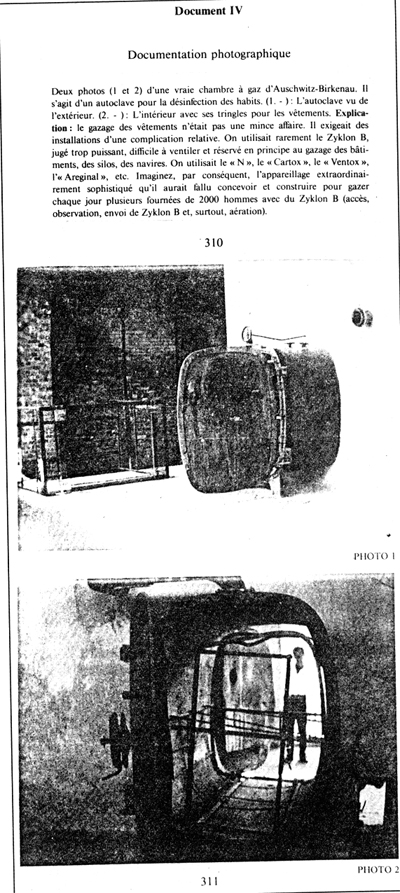|
|
 |
 |
AUSCHWITZ:
Technique
and Operation
of
the Gas Chambers © | |
|
| |
 |
Back |
 |
Contents |
Page 67 |
 |
Home
Page |
Forward |
 |
| |
 |
Extract from a revisionist
publication
(Copy of pages 310 and 311 of "Vérité
historique ou vérité politique. le dossier de l'affaire Faurisson, la
question des chambres à gaz" [Historical truth or political truth,
the file on the Faurisson affair, the question of gas chambers], by Serge
Thion. La Vieille Taupe. April 1980] |
| Document IV Documentation photographique Deux photos (l et 2)
d'une vraie chambre à gaz d'Auschwitz-Birkenau II s'agit d'un
autoclave pour la désinfection des habits. (l.-) L'autoclave vu de
l'extérieur. (2.-): L'intérieur avec ses tringles pour les
vêtements. Explication: le gazage des vêtements n'était pas
une mince affaire. Il exigeait des installations d'une complication
relative. On utilisait rarement le Zyklon B, jugé trop puissant.
difficile à ventiler et reservé en principe au gazage des bâtiments,
des silos, des navires. On utilisait le "N," le "Cartox," le
"Ventox," l' "Areginal," etc. Imaginez, par conséquent,
l'appareillage extraordinairement sophistiqué qu'il aurait fallu
concevoir et construire pour gazer chaque jour plusieurs fournées de
2000 hommes avec du Zyklon B [accès, observation, envoi de Zyklon B
et, surtout, aération). |
| |
Translation:
Document IV
Photographic
documentation |
| |
| Two photographs (1 and 2) of a real gas chamber in
Auschwitz-Birkenau. It is an autoclave for the disinfection of
clothing (I): the autoclave seen from the outside. (2): the interior
with the rails to hang clothing. Explanation: the gassing of
clothes was not an easy business. It required relatively complicated
installations. Zyklon-B was rarely used, considered too powerful,
difficult to ventilate and was generally kept for gassing buildings,
silos, ships. The products used were "N," Cartox, Ventox, Areginal,
etc. Imagine, therefore, the extraordinarily sophisticated equipment
that would have had to he designed and built to gas every day
several batches of 2000 people with Zyklon-B (access, observation,
introduction of Zyklon-B and, above all,
ventilation). | |
|
| AUTOCLAVES OR GAS CHAMBERS?
|
| |
"Document IV" above is presented by Faurisson in
support of his thesis that gas chambers are very complex pieces of
equipment. Photo 1 is the present state of the scene in Photo
35, and Photo 2 is the equivalent of 28. The
documentation provided is limited to these two photographs.
I would point out first of all the immediate contradiction
in the first two lines explaining photos 1 and 2 stating that a gas
chamber is an autoclave. The definition of autoclave according to
the Encyclopedie internationale des sciences et des
techniques (in 10 volumes), Presse de la Cite, volume 2,
page 87, is as follows: |
| |
The autoclave (from Greek autos and Latin
clavis "which closes itself."), is an apparatus derived
from the principle of the pressure cooker of Denis Papin
(1647-1714) whose hermetic closing is obtained by internal
pressure of steam (underlined by the author) which produces a
sharp rise in temperature, to which the enclosed objects of
materials are subjected (generally to sterilize them).
|
In a conventional delousing gas chamber, the operation of the
gas depends on its concentration and the duration of contact. The
gas fills the entire volume of the gas chamber, and the pressure
exerted by it in normal practice, though there may he exceptions, is
infinitesimal, and does not require anything in the nature of an
"autoclave."
Through the lack of any specific German
written documents, which nevertheless must have existed,
indicating in black and white that the Topf disinfesting ovens
worked with hot air and the autoclaves with steam (a statement of
the obvious), it is not possible to formally prove that the
autoclaves were not gas chambers. But Photo 35 showing a
pressure gauge for monitoring the steam pressure and a thermometer
for the temperature suffices in itself to make up for this initial
lack of proof.
The "revisionists" are past masters in this
type of squabbling over the strict interpretation of documents. The
argument may therefore remain undecided for a long time and its
duration may confuse many people with only limited knowledge of
Auschwitz. This revisionist tactic "pays off" as long as there is no
new evidence. The day when a newly discovered drawing or letter
makes it possible to explain the reality in black and white the
"revisionists" will be routed. |
| |
| CONCLUSION |
| |
The presentation of project drawings, definite drawings,
contemporary photographs and present-day photographs of the Zentral
Sauna will have enabled the reader to familiarise himself with and
understand the way in which the Bauleitung members worked and the
evolution and transformations that may occur in a building. The
design of Birkenau Krematorien II, III, IV and V are no exception to
this rule and we shall find a similar evolution there.
I
have also taken the example of the Zentral Sauna autoclaves to show
the difficulty of finding documents to refute certain affirmations –
quite manifestly erroneous – made by the revisionists. i.e. that an
autoclave is not a gas chamber.
Lastly I would point out to
visitors that the Zentral Sauna is not normally open to visitors but
the Polish staff of the museum never refuse a request to see it.
| |
| |
AUSCHWITZ:
Technique
and operation
of the gas chambers
Jean-Claude Pressac
© 1989, The
Beate Klarsfeld Foundation |
 |
Back |
Page 67 |
Forward |
 |
|

